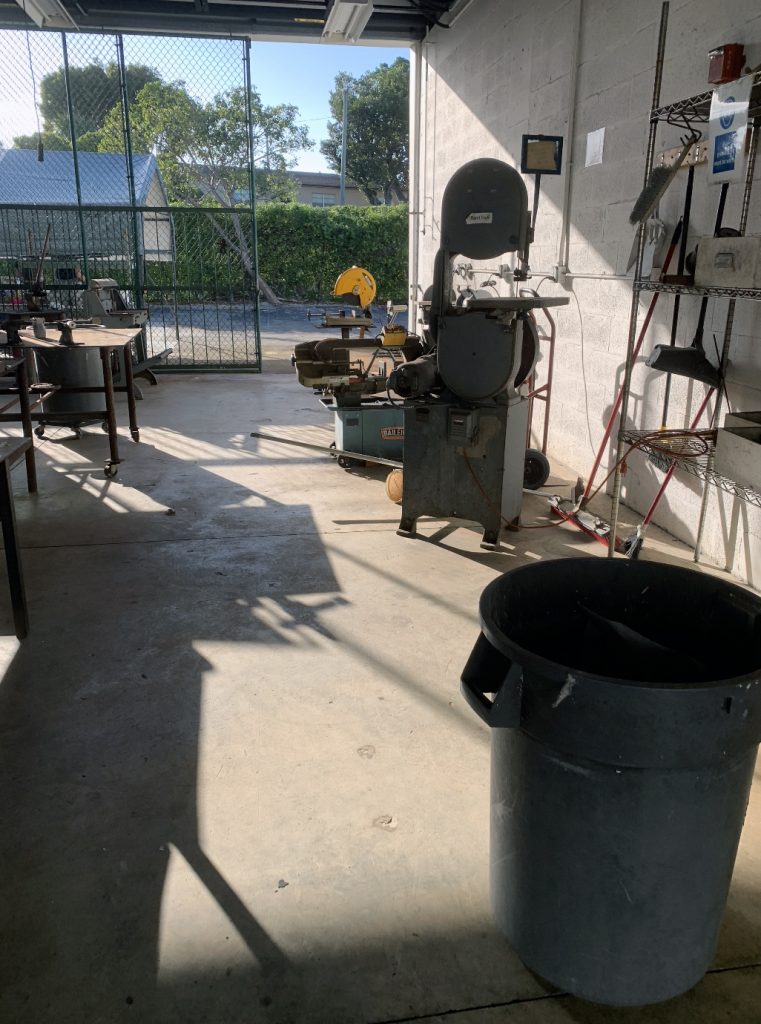Posted February 21, 2021
By MADISON SCHURR
Currently, the N95 mask is viewed as an integral part of the gear protecting healthcare workers, but pre-pandemic, the N95 was also seen as an integral part of protecting construction workers, commercial painters, and, yes, artists.
The N95 mask has been trusted by artists for decades in order to shield their bodies from the chemicals and dust that can be easily inhaled when working with certain media.
As the coronavirus pandemic rages on, N95 masks have become increasingly rare, leaving many artists without the facial coverings they once relied on to stay safe while creating art.
Sculptors are at an especially high risk when working without N95 masks, as many of their predominant media produce fine particles that can be easily inhaled and cause harm to the lungs.
Peter Symons, a sculpture professor at the University of Miami, warns his students especially about the dangers of inhaling plaster dust.
Symons explained that plaster is purchased as a dust and then mixed with water to create a liquid which quickly solidifies. If the dust is inhaled, it reacts with the water in lungs and can harden and create long-term breathing issues.
In order to minimize the risk of excessive dust inhalation, UM’s Art Department uses an outdoor studio in the Studio Arts Courtyard located within the school’s nearby art campus for plaster work.
Dr. Mehdi Mirsaeidi, a pulmonologist and professor at UM’s Miller School of Medicine, warns that excessive inhalation of plaster dust often results in the development of inflammatory respiratory diseases.
Mirsaeidi explained that plaster dust inhalation can cause bronchitis, severe inflammatory reactions, asthma and an increased risk of pulmonary fibrosis.
Mirsaeidi classifies plaster dust as a “construction particle.” He added that he frequently studies the link between construction particles and the development of lung diseases.
“I work on it a lot; it is one of the things I’m very interested [in]. As a lung doctor, I see people working in construction and being exposed to particle matters and they develop very severe lung [issues],” noted Mirsaeidi.
Artists that work frequently with plaster and other dangerous construction particles are urged to use protective facial coverings in order to avoid long term respiratory disease.
Though N95 masks are best for preventing plaster dust inhalation, Symons urges his sculpture students to wear the more accessible KN95 mask when working with plaster. KN95 masks are slightly less effective than the elusive N95, but are commonly regarded as the next best option.
“It’s not ideal,” Symons said about his students only being able to use KN95 masks.
“When I’m working in my own studio, I wear a respirator,” Symons added.
According to 3M, the manufacturer of both the N95 and KN95 masks, the major difference between the two are the rates of particle penetration from the seal or filter of the mask. N95 masks do not allow any particle penetration, while KN95 masks allow 8% of particles to penetrate.
KN95 masks are widely available to the public, while the distribution of N95s have been regulated by the U.S. government.
The FDA website advises that “N95 [masks are] not for use by the general public…. Those are critical supplies that must continue to be reserved for healthcare workers and other medical first responders.”
Attempting to purchase an N95 mask online is extremely difficult. According to company statements, Google, Amazon and Facebook have all blocked the advertising of N95 masks and other personal protective equipment (PPE) in order to keep the gear in the hands of essential personnel.
It is crucial for healthcare heroes to stay protected, but these strict regulations around PPE have made sculptors endanger themselves in the name of art. More cautious or immunocompromised sculptors have had to halt their creation of art all together.
In the depressing times of isolation that have resulted from the COVID-19 pandemic, art has become more important than ever for the mental well-being of humans.
The creation of art often acts as a means of therapy for artists. Artist Noa Farrington noted that she feels her art has made it easier to cope with the pandemic.
“I have been doing a lot more art recently because I have been in quarantine … and I have a lot of built-up energy and frustration that I feel art emotionally fulfills,” said Farrington.
The gatekeeping of N95 masks raises questions about how the U.S. views its artists. On the surface level, many do not see the artist as an essential worker, but in such a monumental and depressing era, art has become the backbone of society’s happiness.
It is not just the lack of N95 masks burdening sculptors. The overlap between products used by medical personnel and artists goes beyond facial coverings.
Symons noted that sculptors are struggling with the excessive prices that have resulted from the increased demand for certain items. As businesses and the general public attempt to adapt to the coronavirus pandemic, the cost of protective products has surged.
“I tried to buy a sheet of plexiglass for a sculpture, which usually costs around $40, but [it cost] over $200,” Symons said.
“The disposable gloves [sculptors] use to mix up chemicals are expensive now as well,” added Symons.
Protective equipment will become more available to sculptors as the pandemic relaxes, but after almost an entire year of shortages and price markups, artists are frustrated and eager to get back to work.

